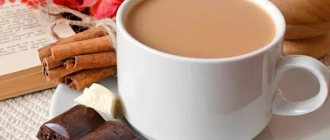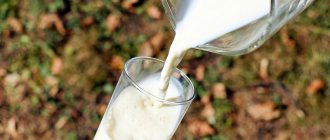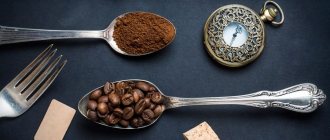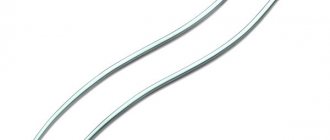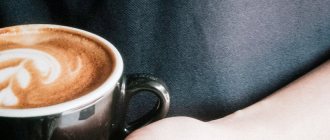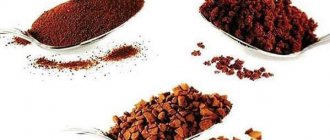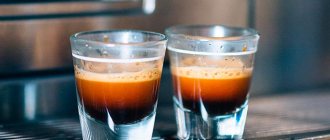How many milliliters are in a standard mug?
Summary of the article:
It is very difficult to imagine our life without such basic kitchen and household utensils as mugs and glasses. Not a single morning, tea party or feast is complete without them. Depending on how many ml are in the mug, it can have very different purposes and uses.
Meaning and origin of the word "mug"
According to information from explanatory dictionaries, a mug is a generalized name for kitchen and tableware that is used for eating, as well as for storing and containing a wide variety of drinks. As a rule, dishes made of glass or ceramics have thick walls and a handle in the form of a bow on the side surface. This design allows you to pour both cold and hot drinks into it.
As for the shape, the vessel most often resembles a cylinder or a truncated cone, but mugs are also available in spherical and ellipsoidal shapes, as well as in the form of various figures (animals, objects, etc.).
Depending on the manufacturer, the capacity of the cutlery varies from 230 to 500 milliliters. However, there are also options that can hold liquid up to one liter. The average capacity of mugs is 250 ml.
The word itself has quite an old origin and dates back to the 15th century and was borrowed from the Polish language, from which “kruz” means jug. In such a vessel, the upper diameter is larger than the lower one, and it itself was made of clay.
Standard mug: how many ml is in it?
Since the industry has reached a high level of development, this tableware can be made from:
- Glass;
- Ceramics;
- Metal;
- Trees;
- Porcelain;
- Plastic.
The choice of kitchen utensils will primarily depend on its intended purpose. But it is worth considering that a standard mug holds 250 milliliters, regardless of what material it is made of.
For example, plastic and metal mugs are most often used in tourism, during travel or long trips. They differ from others in their low weight and good impact resistance, and are not subject to deformation. The volume of such products is on average 250-300 ml. On a hike or on vacation, you don’t have to worry about your mug breaking.
Tableware made from glass or ceramics mainly found its use in home use. Every housewife wants to have beautiful mugs of original shape and design in her kitchen.
Cheap options involve plain-colored dishes, while more expensive ones are represented by mugs with drawings and prints or hand-painted ones. Since such dishes are used in everyday life for drinking tea or other drinks, for example, juices or carbonated sweet water, buyers try to choose a large-capacity mug. Accordingly, manufacturers focus on producing products from 250 to 420 milliliters.
Porcelain mugs are considered the most expensive. They often find their use in expensive restaurants or other establishments. The same housewives who have such items in their dining arsenal use them when receiving dear guests, and some simply collect them.
Porcelain products, as a rule, are decorated with paintings, beautiful designs and have various decors, and their capacity is often no more than 200 ml.
Thermal mugs: at the peak of popularity
Thermal mugs, which have become very popular in all areas of everyday life, deserve special attention. This dish is a small thermos, the inner walls of which are made of ceramic metal. From the outside, this product resembles a tall metal glass with a lid and a small hole for drinking. Initially, such mugs were used by tourists or military personnel. The storage temperature for drinks can reach up to 8 hours. The capacity of such products ranges from 250 ml to 1 liter.
Now the scope of their application has grown significantly. Mini thermoses are very popular among office workers who spend almost the entire working day at the desk and computer, and do not always have time for drinking tea.
In addition to such thermoses, very common are mugs, the outer side of which can change its color depending on the temperature of the liquid inside. When you pour hot tea or coffee, a design or pattern appears on the mug. As it cools down, the image gradually disappears.
Tableware that combines the functions of a blender and a glass is called blender mugs. Such devices have a small electric motor powered by batteries or batteries, and can easily prepare cocktails or other drinks for you. True, they can hold no more than 350 ml of liquid, since part of the space in the case is occupied by the motor itself.
Where else are these containers used?
In addition to their intended purpose, mugs are also used in the preparation of various dishes as measuring cups or for storing flour, sugar or cereals. Many housewives have decorative vessels in their kitchens in which they hold cutlery. Speaking about this use of mugs, it is worth noting that often their capacity is at least 500 ml. They can be decorated with decorative elements and are not designed for storing liquids. There are also products that can easily be put on fire without fear of deformation.
Liter containers can be used as flower pots or vases. The use of such metal or glass mugs depends on your imagination and imagination. True, the price of such items can be much higher than their counterparts for their intended purpose. Therefore, if you have an old metal or glass mug lying around, do not rush to get rid of it. Perhaps it will fit perfectly into the interior of the kitchen or living room.
In general, we can say that the direct purpose and relevance of use will be directly proportional to how many ml are in the mug, and the second criterion for choosing a given product will be the material and color. The price will also be important, because for some this type of dishware is a trifle, while others like to sit down in bad weather with their favorite mug and an interesting book, covered with a warm blanket.
Video: how to get the right amount of liquid without a measuring cup?
In this video, Tatyana Morina will show you how to measure 300 ml of liquid without a measuring cup, using a jar:
Characteristics of the mug
In the classic version, it is a cylindrical vessel, complemented by a comfortable handle. You can drink cold and hot liquids from such dishes. The standard characteristics of a mug can be expanded if we consider what material it is made of and what shape it has. The volume may also vary depending on the purpose of the product.
The manufacturing material can be:
- porcelain - the cup maintains the temperature of the drink for a long time, and does not heat up at all. The material looks impressive, but it is very fragile and expensive;
- earthenware is an excellent analogue to porcelain, but the mug looks rougher - its walls are thicker. Considered ideal for home use;
- ceramics – has all the advantages of porcelain. Dishes made from such material are not very attractive, they quickly wear out and deteriorate, but they are cheap;
- glass is a modern alternative to all of the above options. The cup cools down quickly, and so does the drink itself. The vessels have an original, varied design. The price is affordable;
- glass ceramics – there are no pores in the walls of such dishes, so the products are very durable, retain heat well, and are easy to clean;
- metal: silver, stainless steel, copper, aluminum - silver mugs look elegant, but are not suitable for everyday use. Silver darkens quickly and requires careful care to maintain its shine. Copper mugs are beautiful and have an interior lining of another metal. Suitable for festive occasions or daily use. Stainless steel mugs are resistant to mechanical damage and do not require special care. A great option for every day. Aluminum products are purchased mainly as a traveling option. This mug is light in weight and can be used to boil water if necessary. The type of metal determines the cost of the product.
Comparative table of measures and weights of products, in grams
3 teaspoons = 1 tablespoon 4 tablespoons = 60 ml 5 tbsp. spoons + 1 teaspoon = 80 ml 8 tablespoons = 125 ml pinch = less than 1/8 teaspoon
1 glass = 250 ml
An ordinary faceted glass filled to the top is 250 ml. The risk is considered to be 200 ml. To find out how many grams of product are in a 200 ml glass (mug), divide the weight from the corresponding cell by 5 and multiply by 4.
Culinary table of measures and weights of products
| Product Name | In a glass (250ml), grams | In a tablespoon, grams | In a teaspoon, grams | 1 piece, gram |
| Orange | — | — | — | 100-150 |
| Peanuts, shelled | 175 | 25 | 8 | — |
| Eggplant | — | — | — | 200-220 |
| Jam | 350 | 45 | 20 | — |
| Fresh cherries | 190 | 30 | — | — |
| Water | 250 | 18 | 5 | — |
| Carnation | — | — | — | 0,06 |
| Peas | 230 | — | — | — |
| Peas, unshelled | 220 | — | — | — |
| Dry mustard | — | — | 4 | — |
| Gelatin powder | — | 15 | 5 | — |
| Raisin | 190 | 25 | 7 | — |
| Cocoa powder | — | 25 | 9 | — |
| Potato | — | — | — | 75-100 |
| Citric acid (cr.) | — | 25 | 8 | — |
| Fresh strawberries | 150 | 25 | — | — |
| Ground cinnamon | — | 20 | 8 | — |
| Ground coffee | — | 25 | 9 | — |
| Potato starch | 200 | 30 | 9 | — |
| Buckwheat | 210 | 25 | 8 | — |
| Semolina | 200 | 25 | 8 | — |
| Oatmeal | 170 | 18 | 5 | — |
| Pearl barley | 230 | 25 | 8 | — |
| Barley groats | 180 | 20 | 6 | — |
| Bay leaf | — | — | — | 0,2 |
| Liquor | — | 20 | 7 | — |
| Lemon | — | — | — | 75-100 |
| Bulb onions | — | — | — | 30-50 |
| Poppy | 155 | 18 | 5 | — |
| Fresh raspberries | 140 | 20 | — | — |
| Melted margarine | 230 | 15 | 4 | — |
| Melted animal butter | — | 20 | 10 | — |
| Vegetable oil | 240 | 17 | 5 | — |
| Butter | — | 20 | 10 | — |
| Ghee | — | 17 | 5 | — |
| Honey | 350 | 28 | 7 | — |
| Almond (kernel) | 160 | 30 | 10 | — |
| Condensed milk | — | 30 | 12 | — |
| Powdered milk | 120 | 20 | 6 | — |
| Whole milk | 255 | 18 | 5 | — |
| Potato flour | 180 | 30 | 10 | — |
| Corn flour | 160 | 30 | 10 | — |
| Wheat flour (1 s.) | 160 | 25 | 8 | — |
| Cucumber | — | — | — | 100-120 |
| Ground nuts | 120 | 20 | 7 | — |
| Hazelnut (kernel) | 170 | 30 | 10 | — |
| Flavored peppercorns | — | — | — | 0,06 |
| Hot peppercorns | — | — | — | 0,05 |
| Bulgarian pepper | * | * | * | 50-150 |
| Ground red pepper | — | 10 | 5 | — |
| Ground black pepper | — | 12 | 6 | — |
| Parsley (root) | — | — | — | 50-75 |
| Jam | — | 25 | — | — |
| Tomato | — | — | — | 75-100 |
| Millet | 220 | 25 | 8 | — |
| Strawberry puree, etc. | 350 | 50 | 17 | — |
| Radish | — | — | — | 15-25 |
| Radish | — | — | — | 150-200 |
| Turnip | — | — | — | 75-100 |
| Rice | 230 | 25 | 8 | — |
| Sawed sugar | 200 | — | — | — |
| Granulated sugar | 200 | 25 | 10 | — |
| Powdered sugar | 180 | 25 | 10 | — |
| Beet | — | — | — | 75-100 |
| Celery (root) | — | — | — | 75-100 |
| Cream | 250 | 14 | 5 | — |
| Sour cream | 250 | 25 | 10 | — |
| Fresh currants | 180 | 30 | — | — |
| Drinking soda | — | 28 | 12 | — |
| Fine salt | 325 | 30 | 10 | — |
| Rusks in slices | — | — | — | 20-50 |
| Breadcrumbs | 125-40 | 20 | 5 | — |
| Fermented milk cheese | — | 17 | 5 | — |
| Tomato paste | — | 30 | 10 | — |
| Tomato sauce | — | 25 | 8 | — |
| Vinegar | 250 | 15 | 5 | — |
| Beans | 220 | 30 | 10 | — |
| Cornflakes | 50 | 7 | 2 | — |
| Oat flakes | 100 | 14 | 4 | — |
| Wheat flakes | 60 | 9 | 2 | — |
| Dry tea | — | 10 | 3 | — |
| Prunes | 250 | 25 | — | — |
| Dried apples | 70 | — | — | — |
| Apple | — | — | — | 75-100 |
| Egg powder | 100 | 25 | 10 | — |
| Chicken egg | — | — | — | 40 |
Bulk products in the table are indicated with their natural slide, that is, how much you grabbed with a spoon and can easily move without spilling.
Often in recipes the weight of products is indicated in grams, but not everyone has a kitchen scale that can measure how many grams, for example, are in a tablespoon of sugar or salt. I always have such a table at hand, it lists the main products and how many grams of them fit in a glass, tablespoon or teaspoon.
Meaning and origin of the word "mug"
According to information from explanatory dictionaries, a mug is a generalized name for kitchen and tableware that is used for eating, as well as for storing and containing a wide variety of drinks. As a rule, dishes made of glass or ceramics have thick walls and a handle in the form of a bow on the side surface. This design allows you to pour both cold and hot drinks into it.
As for the shape, the vessel most often resembles a cylinder or a truncated cone, but mugs are also available in spherical and ellipsoidal shapes, as well as in the form of various figures (animals, objects, etc.).
The word itself has quite an old origin and dates back to the 15th century and was borrowed from the Polish language, from which “kruz” means jug. In such a vessel, the upper diameter is larger than the lower one, and it itself was made of clay.
How many grams are in a glass: a convenient table of measures and weights of products in grams
When preparing almost any dish, we measure the amount of necessary ingredients in our usual ways, be it a glass, cup or spoon. And everything would be fine, but not everyone’s glasses and cups are the same, and many recipes indicate the weight of the desired product in grams.
In such cases, an indispensable thing is a measuring cup, which indicates both the number of milliliters for various types of liquids and the weight in grams for dry products. Even with this useful kitchen appliance, it doesn't hurt to know the capacity of the utensils most commonly used when preparing food.
A teaspoon contains 5 ml of water, a tablespoon is three times more, that is, 15 ml; The faceted glass familiar to everyone, which is also called “Stalinist” or “Soviet”, comes in two types - with and without a smooth rim. A glass with a rim is considered a tea glass, since it was in it that conductors on trains served tea throughout the carriage; the volume of this glass is 250 ml; the same glass, but without the rim - 200 ml.
It is important to remember that the volume of the dishes is not always equal to the weight of the product. For approximate data, a table of measures and weights of products may be useful. Many dry foods weigh much less in grams than their volume in milliliters.
The tables below offer weight-equivalent volumes in grams, breaking down foods into convenient subcategories.
Note: The table of measures and weights of products in grams is designed taking into account the filling of dishes as follows:
- spoon - with a small slide;
- glass - to the brim;
- jar - up to the neck.
This type includes cereals, sugar, salt, flour and some others. The table for measuring the weight of bulk products offers the main methods of measurement - a spoon and a glass, dividing them into several types, according to volume. For the convenience of preparing large portions, half-liter and liter jars were added.
Always read the recipe carefully - one cup of flour does not mean 200g of flour, even if your cup is slightly larger than 200ml. Remember that in a “Stalinist” tea glass, filled to the brim, there is only 160 g of flour.
Note: If you don’t have a traditional cut glass on hand in your kitchen, you can replace it with a plastic one. A standard transparent disposable polypropylene glass holds exactly 200 ml of water.
| Product name | Measures of weight in grams | ||||||
| Spoon | Cup | 0.5 liter jar | 1 liter jar | ||||
| tea room | dessert | dining room | 200 ml | 250 ml | |||
| Salt | 13 | 25 | 40 | 255 | 320 | 640 | 1280 |
| Bulgur | 8 | 15 | 25 | 190 | 235 | 470 | 940 |
| Peas | 8 | 15 | 25 | 185 | 230 | 460 | 920 |
| Pearl barley | |||||||
| Rice | |||||||
| Couscous | 8 | 15 | 25 | 180 | 225 | 450 | 900 |
| Millet | 8 | 15 | 25 | 175 | 220 | 440 | 880 |
| Buckwheat | 7 | 15 | 25 | 165 | 210 | 420 | 840 |
| Sugar | 10 | 20 | 30 | 160 | 200 | 400 | 800 |
| Semolina | 8 | 15 | 25 | ||||
| Corn flour | 10 | 20 | 30 | 145 | 180 | 360 | 720 |
| Wheat groats | |||||||
| Barley groats | |||||||
| Wheat flour | 8 | 15 | 25 | 130 | 160 | 320 | 640 |
| Powdered milk | 4 | 8 | 15 | 100 | 120 | 240 | 480 |
| Oat flakes | 5 | 10 | 15 | 80 | 100 | 200 | 400 |
| Hercules | 4 | 9 | 15 | 60 | 75 | 150 | 300 |
| Cornflakes | 3 | 6 | 10 | 50 | 60 | 125 | 250 |
Spices and additives (ground)
Since the preparation of most dishes requires little spice, the main measurements are teaspoons and tablespoons. For convenience, a dessert spoon was added, the standard volume of which is 10 ml. Weights of food in spoons are not equivalent to their volume.
The weight of most spices and additives depends on the grind and quality of the product. For example, coarsely ground coffee will weigh slightly more than finely ground coffee.
Note:
- The table of weights and measures of products in grams does not guarantee an absolutely accurate weight, since the consistency and size of many products are not always the same.
- Very often, spices are measured in pinches; one pinch contains about a quarter of a teaspoon.
| Product | Product weight | ||
| Tea spoon | Dessert spoon | Tablespoon | |
| Baking soda | 12 | 24 | 45 |
| Starch | 10 | 20 | 30 |
| Powdered sugar | |||
| Lemon acid | 8 | 15 | 25 |
| Baking powder | |||
| Cocoa | |||
| Cinnamon | 7 | 13 | 20 |
| Ground coffee | |||
| Poppy | 6 | 12 | 18 |
| Gelatin | 5 | 10 | 15 |
| Pepper | |||
| Breadcrumbs | |||
| Mustard | 4 | 8 | 12 |
| Instant coffee | 3 | 6 | 10 |
| Carnation |
Liquids
Liquids are almost always measured in milliliters, which makes cooking much easier since it is enough to know the volume of the container in which food is usually measured. When prescription liquids are measured in grams, their weight is as close as possible to the volume.
| Liquid product | Product weight in grams | ||||||
| Tea room (5 ml) | Dessert l. (10 ml) | Dining room l. (15 ml) | 200 ml | 250 ml | 500 ml | 1000 ml | |
| Water | 5 | 10 | 15 | 200 | 250 | 500 | 1000 |
| Milk | |||||||
| Cream | |||||||
| Liquor | |||||||
| Cognac | |||||||
| Vinegar | |||||||
| Ghee | 7 | 14 | 20 | 195 | 240 | 480 | 960 |
| Rendered fat | 5 | 10 | 15 | 195 | 240 | 480 | 960 |
| Sunflower\olive oil | 6 | 12 | 18 | 185 | 230 | 460 | 920 |
| Melted margarine | 5 | 10 | 15 | 180 | 225 | 450 | 900 |
Solid foods
Note: The table of measures and weights of products in grams provides approximate data. The exact weight of products depends on their size and type.
| Product name | Measures of weight in grams | ||||||
| Spoon | Cup | 0.5 liter jar | 1 liter jar | ||||
| tea room | dessert | dining room | 200 ml | 250 ml | |||
| Candied fruit | 10 | 25 | 35 | 220 | 275 | 550 | 1100 |
| Beans | 5 | 15 | 20 | 175 | 220 | 440 | 880 |
| Small lentils | 5 | 15 | 20 | 175 | 220 | 440 | 880 |
| Whole peas | 5 | 15 | 20 | 160 | 200 | 400 | 800 |
| Large lentils | 5 | 18 | 25 | 160 | 200 | 400 | 800 |
| Ground walnut | 10 | 20 | 30 | 155 | 190 | 380 | 760 |
| Raisin | 10 | 20 | 30 | 155 | 190 | 380 | 760 |
| Cherry | 10 | 20 | 30 | 155 | 190 | 380 | 760 |
| Cranberry | 10 | 20 | 30 | 155 | 190 | 380 | 760 |
| Currant | 10 | 20 | 30 | 145 | 180 | 360 | 720 |
| Peanuts, shelled | 8 | 15 | 25 | 140 | 175 | 350 | 700 |
| Peeled hazelnuts | 8 | 15 | 25 | 140 | 175 | 350 | 700 |
| Whole shelled walnut | 10 | 20 | 35 | 135 | 170 | 340 | 680 |
| Strawberry | 8 | 15 | 25 | 135 | 170 | 340 | 680 |
| Peeled almonds | 10 | 20 | 30 | 135 | 170 | 340 | 680 |
| Raspberries | 5 | 10 | 20 | 120 | 150 | 300 | 600 |
Products with viscous consistency
Let's consider the last type of product.
| Product name | Measures of weight in grams | ||||||
| Spoon | Cup | 0.5 liter jar | 1 liter jar | ||||
| tea room | dessert | dining room | 200 ml | 250 ml | |||
| Boiled condensed milk | 12 | 25 | 40 | 280 | 350 | 700 | 1400 |
| Berry/fruit puree | 12 | 25 | 40 | 280 | 350 | 700 | 1400 |
| Jam/Jam | 15 | 30 | 45 | 275 | 340 | 675 | 1350 |
| Honey | 12 | 25 | 40 | 260 | 325 | 650 | 1300 |
| Condensed milk | 12 | 22 | 35 | 240 | 300 | 600 | 1200 |
| Tomato paste | |||||||
| Sour cream | 10 | 20 | 30 | 210 | 265 | 530 | 1060 |
| Mayonnaise | 8 | 15 | 25 | 200 | 250 | 500 | 1000 |
How to measure 200, 250, 300 grams of sugar
To correctly calculate how many vessels are required for a specific mass of a sweet substance, you need to know a simple formula: to find the volume, you need to divide the mass by the density.
When dividing 200 g of sugar by the table density value (0.8 g per cubic cm), you get 250 cm cubic (or 250 ml). This value corresponds to the capacity of a fully filled faceted Soviet container.
Similarly, you can calculate the number of glasses that will be required for 250 g of sweet substance. 250 g of granulated sugar occupy 312.5 cubic cm, which corresponds to filling two vessels: the first should be completely filled, and the second only a quarter.
300 grams of granulated sugar occupy 375 cubic cm. For this volume, you need to take 2 faceted glasses: the first filled to the top, and the second only half filled.
How to prepare tartlets for a festive table with different fillings. Recipes with step-by-step photos and tips. How many grams of flour are in one tablespoon? Read how to measure bulk products if you don’t have scales at hand.
Simple and delicious baked goods for every day. Take note of homemade baking recipes.
How many ml in a cup
WATER SUPPLY AND SEWERAGE DESIGN
Write:
Working hours: Mon-Fri from 9-00 to 18-00 (without lunch)
How much is 650 milliliters?
650 ml (milliliters) is a measure of volume that is a quantitative characteristic of the space occupied by a body, structure or substance. To determine this measure in various dishes, use our calculator. At the end of the page, be sure to look at the information about the volume of dishes used in this calculation. Background information - 650 ml of water is 650 grams.
See also:
— Convert milliliters to liters — Convert milliliters to grams — Convert milliliters to milligrams
— Convert milliliters to other volume measures
The formula for calculating the volume measure is 650/x, where x is the volume of the selected container or measuring device.
For reference:
Tablespoon = 18 ml Teaspoon = 5 ml Glass = 200 ... 250 ml Jar = 200 ... 5000 ml Saucer = 110 ml Barrel = 200000 ml Champagne glass = 150 ml Juice glasses = 250 ml Beer glasses = 500 ml Kettle = 1000 ... 3000 ml Broth cups = 350 ml Tea cup = 200 ml Coffee cup = 70 ml Saucepan = 1000 ... 5000 ml Ladle = 1000 ... 2000 ml Mug = 200 ... 250 ml Bowl = 250 ml Bowl = 250 ml Shot glass = 50 ml Salad bowl = 1000 ... 3000 ml Skimmer = 700 ... 2500 ml Frying pan = 700 ... 2500 ml Saucepan = 700 ... 2500 ml Stack = 100 ml Regular plate = 250 ml Deep plate = 500 ml Bucket = 2000 ... 10000 ml Syringe = 1 ... 100 ml
Pipette = 1…100 ml
Note: the volume may certainly vary depending on the design features of the product.
This page provides a very simple calculation and answer to the question - 650 milliliters is how many grams, spoons, glasses and other products. This is the simplest online calculator for converting 650 ml to other volume measures.
WATER SUPPLY AND SEWERAGE DESIGN
Write:
Working hours: Mon-Fri from 9-00 to 18-00 (without lunch)
How much is 200 grams of water?
200 grams of water is a measure of mass and a derived measure of volume, which is a quantitative characteristic of the space occupied by water in a body, structure or substance.
To determine this measure in various dishes, use our calculator. At the end of the page, be sure to look at the information about the volume of dishes used in this calculation. Background information - 200 grams of water is 200 ml.
See also:
— Convert milliliters to grams — Convert milliliters to milligrams
— Convert grams of water to other volume measures
The formula for calculating the volume measure is 200/x, where x is the volume of the selected container or measuring device.
For reference:
Tablespoon = 18 g Teaspoon = 5 g
Glass = 200...
250 g Can = 200 ... 5000 g Saucer = 110 g Barrel = 200000 g Champagne glass = 150 g Juice glasses = 250 g Beer glasses = 500 g
Kettle = 1000...
How much is in a glass of water (ml, grams)
3000 g Stock cups = 350 g Tea cup = 200 g Coffee cup = 70 g
Pan = 1000...
5000 g Ladle = 1000 ... 2000 g Mug = 200 ... 250 g Bowl = 250 g Bowl = 250 g Glass = 50 g Salad bowl = 1000 ... 3000 g Skimmer = 700 ... 2500 g Frying pan = 700 ... 2500 g
Saucepan = 700...
2500 g Stack = 100 g Regular plate = 250 g Deep plate = 500 g Bucket = 2000 ... 10000 g Syringe = 1 ... 100 g
Pipette = 1 ... 100 g
Note: the mass of water in the dishes can certainly vary depending on the design features of the product.
This page provides a very simple calculation and answer to the question - 200 grams of water is how many milliliters, spoons, glasses and other products.
This is the simplest online calculator for converting 200 grams of water into volume measures.
WATER AND SANITATION DESIGN
Email:
Working hours: Mon-Fri from 9-00 to 18-00 (without lunch)
How much is 150 milliliters?
150 ml (ml) - This is a measure of volume that is a quantitative characteristic of the space occupied by a body, structure or substance.
Use our calculator to determine this measure in different containers. At the bottom of the page, make sure you see the number of products used in this calculation. Basic information - 150 ml of water equals 150 g.
See also:
— Convert milliliters to liters — Convert milliliters to grams — Convert milliliters to milligrams
— Convert milliliters to other volumes
The formula for calculating the volume measure is 150 / x, where x is the volume of the selected container or measuring device.
For reference:
Teaspoon = 18 ml Teaspoon = 5 ml
Glass = 200...
250 ml Can = 200 … 5000 ml Prosciutto = 110 ml Barrel = 200000 ml Shampoo: 150 ml Glass of juice = 250 ml Beer glasses = 500 ml Kettle = 1000 … 3000 ml Soup bowls = 350 ml Tea cup = 200 ml Coffee cup = 70 ml Pan = 1000 … 5000 ml
Bucket = 1000...
2000 ml Bread = 200 … 250 ml Container = 250 ml Piala = 250 ml Glass = 50 ml
Salad bowl = 1000...
American quantity and weight
3000 ml Noise removal = 700 ... 2500 ml Brush = 700 ... 2500 ml Stewpan = 700 ... 2500 ml Drain = 100 ml Regular plate = 250 ml Dish = 500 ml Bucket = 2000 ... 10,000 ml Syringe = 1 ... 100 ml
Pipette = 1…100 ml
Note. The volume may vary depending on the design features of the product.
This page is a very simple calculation and answer to the question - 150 milliliters is the number of grams, spoons, glasses and other products.
This is the easiest calculator to convert 150ml to other volumes.
SOLUTIONS
W = m solute / m solution Assume that one cup of sugar is in a cup, which is 9 grams the mass of water is approximately equal to its volume w sugar in a circle = 9 g: 300 g = 0.03 (which corresponds to 3%)
w sugar in container = 9 g: 200 ml = 0.045 (4.5%)
It's just about using the formula
Similar vacancies:
- 1) What volume of 5% of the density of 1.1 g/ml alkaline Ba (OH) 2 should be taken to neutralize 10 ml of 0.1 M hydrochloric acid solution?
2) What is the molar concentration of a 10.06% solution... Topic: How much acid - 70 g of 8% sugar solution was added to 70 ml of water.
How many milliliters are in a glass
Sugar content (%) in the resulting solution. can be obtained using formulas, a solution that I don't understand...Topic: How much weight can you get?
- A mixture of hydrogen sulfide with excess oxygen (nu) was blown out in a sealed container with a volume of 1.5 liters. The reaction products were dissolved in 49.2 ml of water, and the acids were obtained as a percentage by weight of water. Topic: What weight can you get?
- Prepare a sugar solution of 30 g 10% ... Topic: Preparing a solution
- How much oxygen can be obtained from 400 liters of air if the volume of oxygen in the air is 21% ... Topic: According to the thermochemical reaction equation
Standard sizes of faceted glass
How else can you find out the volume of a glass? Simply, to do this, you can measure the glass with a ruler or centimeter. The answer to the question will be determined by the dimensions of a standard faceted glass:
- The number of edges can vary from 16 to 20 pieces;
- The outer height with the rim (with notch) is 105 mm;
- The height of the rim (rim) of the glass is approximately 14 mm;
- The diameter of the base on the outside is 55 mm;
- The diameter of the upper part from the outside is 73 mm.
You need to understand that the volume of a faceted glass and the weight of sugar poured into it have different digital values. All foods and liquid substances, besides water, have different densities; in the case of sugar, the exact weight is affected by the size of the grains (crystals) of different types of granulated sugar.
Accordingly, different products placed in the same volume measure will have different weights. The difference in the weight of granulated sugar when cooking is minimal. In everyday life, a cut glass is considered to be the standard of weight.
Popular diets
I think you are wondering how many grams a mug can contain of both liquid products and dry, bulk products. I will say right away that the mugs are different, that is, their volume. I have 200 gram, 250 gram, and even 300 gram mugs at home, but we usually don’t use them to measure anything. I often cook baked goods and I always use a 250 gram mug to measure food - it’s more convenient, because recipes often give measurements in glasses. So, here is the weight of some products in a standard 250 gram mug:- water - 250 grams, flour or semolina 160 - 170 grams, if with a slide, sugar 220 - 230 grams, vegetable oil 240 - 250 grams.
The weight in a glass of a particular product in grams will directly depend on the product itself.
There are a great many tables on the Internet that show the content of any product in a glass in grams. Here are just a small number of the most popular products that are most often measured in glasses.
We will be talking about a full glass of medium size (standard), not faceted.
Water – 250 milliliters (or grams).
Flour – 160 grams.
Salt – 350 grams.
Sugar – 200 grams.
Etc. and so on.
Again, you can see a detailed description of the mass of a particular product in a glass in a table on the Internet, of which there are a lot.
I can say for sure that mugs, like glasses, can have different volumes, but mugs and glasses have one great similarity - they can be 250 grams and this will often be the standard size encountered in life. Nowadays, 250-300 ml of water fits in a medium-sized mug is common. I advise you to calculate the number of grams using faceted glasses, since it is not convenient with a mug. Water – 250, grams. Flour – 160 grams. Salt – 350 grams. Sugar 200 g - regular ingredients.
You can’t say for sure, because the circles are different. Usually 200 ml of water is placed in a small mug, about 300-350 ml in a medium-sized mug. Therefore, it is more convenient to convert to faceted glasses. They, like a small cup, contain 200 ml of water. And if the cup is larger, then we recalculate. Although, if the volume is small, it is easier to count in tablespoons.
It all depends on the specific substance that we pour into this mug.
If we take a mug equal to a glass, that is, 200 grams, then:
Science is not tricky if the volume of a mug is equal to a faceted glass. If it’s more or less, you’ll have to calculate it yourself.
Most modern medium-sized mugs hold 250-300 ml, but how much it will be in grams, kilograms, and so on is impossible to say without specifying what the mugs are going to measure. For example, there is such a sign:
Do you know the answer?
Source: www.bolshoyvopros.ru
What does volume depend on?
The volume is influenced by two main parameters - shape and purpose. The balance of characteristics is fundamental for the manufacturer and the buyer. The volume of the mug can vary from 0.03 to 1 liter. Much depends on how and where the container will be used. The standard capacity is 250 ml.
Form
The volume directly depends on the size of the mug and its shape. If the container has a standard cylinder shape, its capacity will be maximum. When the dishes have all kinds of contractions, expansions, and transitions, this parameter decreases. The larger the shape of the container, the smaller its volume.
There are 2 main shapes of a mug. The glass-shaped one has an elongated body, so at a significant height it holds little liquid. Pial-shaped is distinguished by a spherical shape, which is slightly narrowed downwards. The larger the volume, the wider the vessel.
Purpose
The volume of the cup is determined by the purpose, according to which manufacturers think through the following parameters:
- metal and plastic specimens are often used on hikes and in everyday life, so their volume is usually 250-300 ml. There is a liter mug for certain tasks;
- porcelain and ceramic options are rarely used. They serve more as a decoration for an exquisite tea party, so they hold no more than 200 ml of liquid;
- containers that are used in everyday life for cold and hot drinks can have a capacity of 250 to 420 ml;
- blender mugs are suitable for certain manipulations with liquids, so the parameters can be equivalent to a half-liter jar;
- bouillon cups are designed for serving soups, have two handles and hold from 250 to 650 ml;
- Thermal mugs are used as containers for food or drink. The capacity of such dishes can reach 0.7 liters.
When choosing a mug, it is worth considering that its filling capacity will be less than its actual volume.


